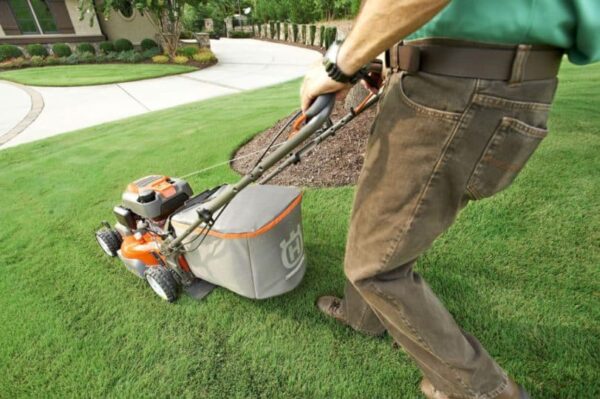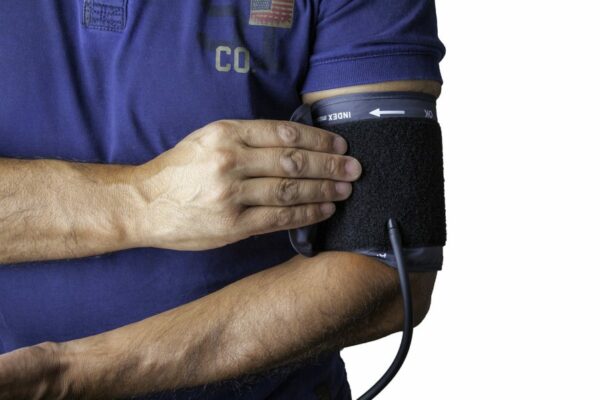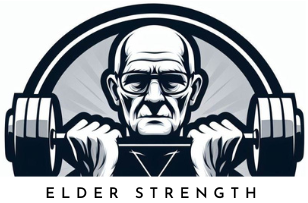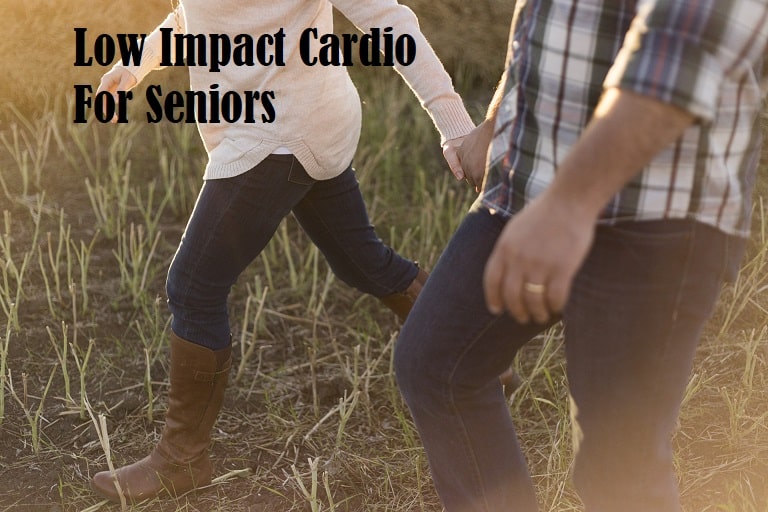In this article, you will learn about low impact cardio for seniors. Low impact cardio doesn’t build significant strength but it has an important function in improving recovery and maintaining endurance and stamina. It also has very beneficial effects on heart health and circulation.
These are all things that naturally decline as we get older. Most of your exercise and activity should consist of low-impact cardio, especially if we count all our daily activities that increase the heart rate as low-impact cardio.
Which we definitely should, as everyday activities like walking, yard work, cleaning, and building things are more important for our overall fitness and physical health than doing a few intense training sessions a week.
Just compare a senior farmer and a senior office worker that goes for a run couple of times a week. The farmer is very likely in much better overall shape and strength if he has managed to avoid working injuries.
Most of these day-to-day activities don’t build and maintain strength. Especially in the whole body. So strength training is very important for your health. But if you live a very active lifestyle otherwise, there might not be a need to do much extra cardio exercise.
But if you don’t live a very active lifestyle, your overall health can benefit greatly from adding a bit of daily low impact cardio to your routine.
Active Lifestyle Is Best Low Impact Cardio For Seniors
So how do you know if you are active enough? Well, this one is hard to answer as it depends a bit on your age and what kinds of activities you do. One of the best ways to find out is to use a simple pedometer to count your steps every day for several weeks. You can use your smartphone as I talked about in the article Free Pedometers For Seniors.
If you routinely hit 10 000 steps or close to it, you are probably active enough already. The problem with this method is that it won’t take into count all activities. And some activities can confuse the counter. Cycling is a typical activity that is very good for health but doesn’t register well with pedometers.
If you are a person that walks or cycles to the grocery store and to most nearby places, choose to use the stairs more often than not, do your own cleaning and have some active hobbies like home improvement, gardening, or golf, you are very likely active enough.

If on the other hand, you are someone who chooses to use a car even for short trips, doesn’t do their own cleaning, and mostly enjoys staying on the couch or in front of the laptop. You probably need some work on your cardiovascular health. Low impact cardio is great for improving your overall health.
Let’s look at what exactly is low impact cardio and what are its benefits before looking at some exercises.
What is Low Impact Cardio For Seniors
Low impact cardio is any continuous exercise that doesn’t increase your heart rate and respiration too much. What exactly is too much is highly individual.
Many trainers consider any type of aerobic exercise where you have one leg at the ground at all times low impact cardio. Another common definition is any type of exercise where you can keep a normal conversation going without running out of breath.
To an athlete, this might mean a good pace jog. While to most of us this means a brisk walk or slow-speed cycling. There is really no lower limit for low-impact cardio as long as it’s continuous and raises your heart rate a bit.
Typically you will get a bit sweaty after a while of low-impact cardio but not so much that you have to immediately take a shower. So taking a walk in the park for an hour can be considered low impact cardio. But if you jog for an hour you will very likely have a soaking wet shirt. This is not low impact anymore.
Low impact cardio can also refer to forms of cardio that don’t produce a significant impact on your joints and spine. This is of course beneficial if you suffer from severe arthritis or other conditions that affect your joints.
Water exercise like swimming has a low impact on the joints but can be quite intense on the cardiovascular system.
Why Is Low Impact Cardio For Seniors Important
Low impact cardio is very important for overall health in all ages. For seniors it’s especially important because as we get older our capacity for higher intensity exercise declines. Our ability to recover from intense exercise and activities becomes longer as well.
Low impact cardio offers several beneficial effects on our health. And it doesn’t require substantial time to recover from. It actually aids in recovering from more intense exercise by improving circulation and the use of nutrients.
Low activity cardio is important because it can be continued for extended periods of time compared to more intense forms of exercise. Time is the most important factor when we look at the overall metabolic effects of exercise. Extended low activity cardio like hiking is great for fat and sugar metabolism and heart health.

This is because low-impact cardio increases heart rate slightly for extended periods of time. It also activates our fat metabolism. The slightly increased heart rate is very good for our arteries which become less elastic with age. Daily low impact cardio can fight this effect to an extent. It also helps to control your blood sugar and prevent diabetes.
The Impact Of Daily Activity
Walking the dog, going to the grocery store on foot, and doing some gardening for an hour or two might not feel like you have done a major workout. But it all adds up because of the extended time. The activities in our example can add up to close to 1000 calories compared to sitting still all day. That’s a lot if you do it every day.
Especially when you compare it to the fact that burning 1000 calories would require a grueling two-hour workout in the gym or a couple of hours of running. And it equals one hefty meal or a couple of doughnuts. Or something else tasty you can eat without packing on the pounds.
So it’s all about being active in every way possible. The little things add up and lying on the couch or sitting in front of the TV or the computer is actually very bad for your health. Unless you compensate with enough active hours during the day.
Low impact cardio is also beneficial for your mental health and cognitive function, so there really is no excuse to not do it!
Low Impact Cardio For Seniors: Exercises
As I have hinted several times already, the best form of low-impact cardio is having an active lifestyle and making choices that support this.
This includes going to places by foot or bike instead of the car. Choosing the stairs instead of the elevator. And having active hobbies like gardening, home improvement, golf, etc. Anything that requires you to get on your feet and do stuff.
If you want some specific exercises because you don’t feel you get enough low-impact cardio during your normal daily activities, don’t worry, I got you covered!
Walking
As boring and mundane as it might sound, my first suggestion is walking. And there’s a very good reason for this. You see we humans are biologically evolved to walk. Everything in our physique is honed and perfected by mother nature for an extended period bipedal cardio like walking.
Walking is the perfect form of low-intensity movement. Most healthy people can’t really walk so fast that it would get too high intensity. Unless walking a very steep incline very fast. It requires no accessories except for decent walking shoes. As I talked about in the article Best Walking Shoes For Seniors.
Walking is best combined with being in nature as both walking and being in nature have been shown to lower stress levels and improve our mood and happiness. These are important things for heart health and quality of life.
It’s almost as if mature nature has given us a gift for walking. Maybe it’s nature’s way to keep us going.
Making Walking More Effective And Enjoyable
Hiking is an exceptionally good form of exercise for seniors. It combines low-impact cardio with bouts of higher intensity when climbing inclines or going through rough terrain. It also improves your balance and coordination and allows you to enjoy the outdoors!
Walking and hiking can be made even more effective and enjoyable by using walking poles. I talked more about this in the article Nordic Walking For Seniors. If you need help with choosing hiking sticks, check out the article Best Hiking Sticks for Seniors [Trekking Pole Guide].
Walking can be done inside on a treadmill but we encourage you to go outside even if you don’t have forests or parks near you. If you want to learn more about low-impact treadmills, check out the article Safe Treadmills For Seniors.
Walking allows you to focus on your surroundings and process your thoughts, something we tend to forget with all the modern-day distractions.
A good routine is to go for a walk every night an hour or two before bed. This allows you to clear your head, get some fresh air and relax your body so you fall asleep more easily.
If you have a dog or decide to get one, this comes naturally of course due to your friends’ needs. If you can’t for some reason go walking I suggest another form of exercise you can do in front of the TV for example.
Cycling
Cycling is a great form of low-impact cardio if done at a slow pace. It’s easier on the knees than walking in case you have knee problems.
Like walking, cycling is best done outside. Cycling with a real bicycle is also great for your balance and leg strength and you can do it in nature like walking.
Just make sure to pace yourself, if your legs are burning and you are breathing heavily you are probably out of the low impact cardio zone. This is not necessarily a bad thing as it’s good exercise. You just have to take it into account in your recovery capacity. A great way to reduce the impact of cycling is by using an electric bike as I mentioned in the article Best Electric Bikes For Seniors.
If you live in the middle of a Metropol or can’t for some other reason go exercise outside, cycling is great for the fact that you can do it at home on a stationary bike. All you have to do is to pedal in a relaxed pace while watching TV or listening to music for example for an hour to get a healthy dose of low-impact cardio.
You can learn more about exercise bikes in the articles Indoor Cycling For Seniors, Best Exercise Bike For Seniors, Peloton For Seniors, and Nordictrack For Seniors.

Other Options
A good option for a stationary bike is also a cross-trainer. It activates a larger portion of your muscles because your upper body is involved. This can be used in a similar manner as a stationary bike for low-impact cardio. Elliptical machines and recumbent bikes are also great options for low-impact cardio. You can learn more about them in the article Best Elliptical Machine For Seniors and Best Recumbent Bike For Seniors With Arthritis.
Real bikes, stationary bikes, and cross trainers can all be used for more high-intensity forms of cardio as well. So they are not a bad investment.
Kayaking is another great low-impact activity. You can find more information and my recommendations in the articles Best Kayak for Seniors and Lightweight Kayaks For Seniors.
Swimming
Swimming is a great form of low-impact cardio if you do it at a slow relaxed pace. Swimming doesn’t cause an impact on the joints and it’s great for muscle activation.
The biggest problem with swimming is that you have to be a confident swimmer to do it for an extended time. Swimming can also be dangerous for seniors if done unsupervised.
That’s why I recommend group classes or water aerobics if available at your location. You can learn more about the benefits of swimming in the article Is Swimming Good For Seniors? and Swimming Exercises for Seniors.
Conclusion
I hope you enjoyed reading about these tips for low-impact cardio for seniors. I encourage you to live an active lifestyle as that reduces the need for specific cardio exercise. You also get the exercise without even noticing it while enjoying your daily activities. And of course, being productive!
Our bodies are meant to be used and the second we stop using them our health starts to deteriorate. This happens in all ages but is especially true for seniors and the elderly.
As we get older we can get aches and pains and feel fatigued. This can lead to a less active lifestyle. Unfortunately, exercise is beneficial for most aches and general fatigue. So avoiding activities only exacerbates the problem. It’s always important to rule out any medical conditions with your doctor. But often it’s lack of exercise and excess weight that’s behind these feelings.
Low impact cardio is especially important for increasing your daily calorie consumption and metabolism. For improving your cardiovascular health. And for improving your mental health. That’s why I recommend you start today and go for a walk if you don’t feel like you are active enough!
See you next time,
Elder Strength


This is a great article, it’s so important for everyone to do some sort of cardio and it’s great to see you encouraging people to exercise within their limits. Do you think swimming can also be beneficial?
Thank you for the comment Amy! Swimming is definitely a good form of low impact cardio if you are a good swimmer and can keep a nice slow pace. Swimming can easily increase your heart rate more than you realize and you don’t notice sweating in the water. Low intensity water aerobics is also an option.
Walking and cycling will be staples for seniors when it comes to cardio. It’s low-impact, as you stated, which will be incredibly easy on the joints and better yet, can be accomplished anywhere, especially walking.
If it’s cold out, shopping malls are great for walking as well as people watching to pass the time! Nature trails are great, too, for both walking and biking.
For those seniors who can no longer go high-impact or are starting to feel wear and tear on their joints, walking and cycling are ways to go.
In my experience working as a trainer in the past, these two activities have also allowed seniors to adopt a permanent fitness program within gyms.
Thanks for the comment Todd! Walking is definitely great because it can be combined with so many other activities and it’s something our bodies are designed to do.
Excellent post. I have many seniors in the group fitness classes I teach (one of the many hats I wear!) and comparing those seniors to people of similar age who do not engage in regular physical activity is like night and day.
And yes, low-impact cardio is a great option. In fact, it’s always an option. Seniors should know that they could attend any fitness class, no matter how “extreme” (and I teach some extreme ones) and any competent instructor will make sure there are low-impact options for them.
Love the site, keep up the good work.
You are absolutely correct Jon! Any exercise is better than nothing. And abundant low impact cardio is actually better for your health and longevity than any “extreme” exercise if it’s combined with sedentary lifestyle otherwise. Great to see a professional trainer who can confirm this with his own observations.
You don’t have to become a power lifter or a marathoner to be healthy. Being active and doing something is enough. Thanks for the input Jon! All the best to you.
Great article. It has a lot of very informative data that covers a lot of things that will help you get in shape and lose weight. I enjoyed reading it.
Thank you Daniel! Glad to hear you enjoyed it.
wow, this article is itself a mini course for low impact cardio exercise…both my parents are heart patients. I will share this amazing information not only with them but also with my elderly neighbors. I really love to read and learn all the informative reads regarding health and fitness and thats what I find in this post. Thank you.
Thanks for the comment Sarah! Low impact cardio is actually the perfect form of exercise for heart patience. As you and your parents surely know, all exercise must be discussed with the the treating physician when there is a diagnosed heart disease. The good news is that exercise combined with dietary changes will improve symptoms and longevity even in patients with established heart disease.